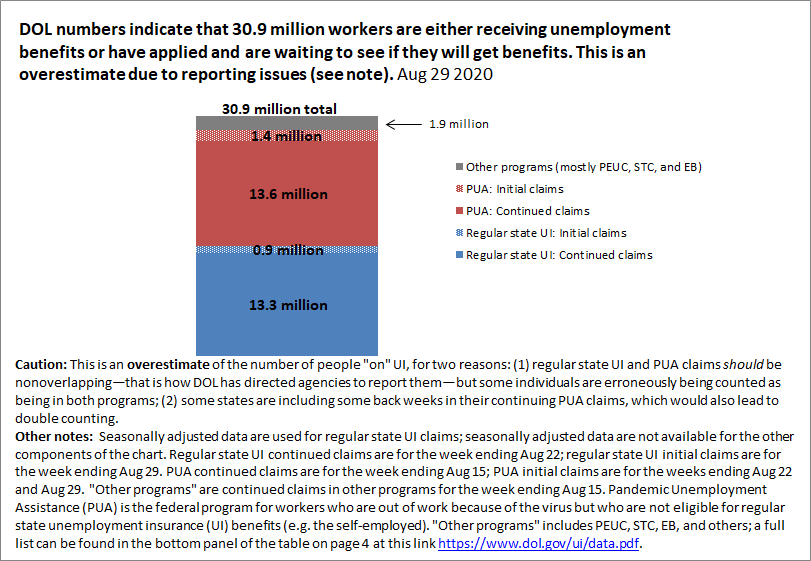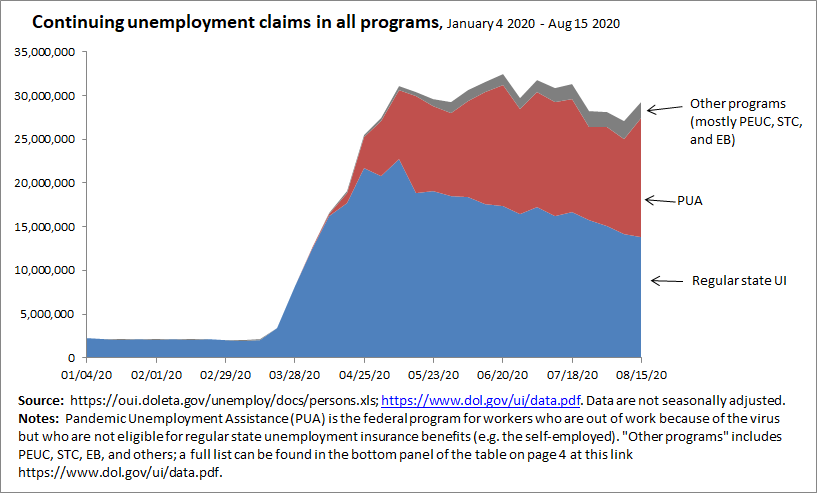Last week, 1.6 million workers applied for unemployment insurance (UI). Breaking that down: 881,000 applied for regular state UI, and 759,000 applied for Pandemic Unemployment Assistance (PUA). 1/ https://www.dol.gov/ui/data.pdf ">https://www.dol.gov/ui/data.p...
There was a good methodological development with the UI data this week! DOL changed their seasonal adjustment (SA) methodology. The way they were doing seasonal adjustments before was causing major distortions during this recession. The change is a big improvement. 2/
One BIG problem, however, is that they didn& #39;t revise prior seasonally adjusted data, which means you can’t compare seasonally adjusted numbers over time (you really can’t). So, remember this: If you want to compare UI data over time, use not-seasonally-adjusted (NSA) numbers. 3/
Some are saying regular state UI claims dropped by 130,000 last week (from 1 mil to 881,000). NO. That’s comparing SA numbers that were calculated using 2 different methods. Regular state UI claims actually ticked UP by 7,600 last week from 825,800 to 833,400 (using NSA data). 4/
If you include initial PUA claims, claims rose 159,000 last week, from 1.43 million to 1.59 million. This is the fourth week in a row that total initial claims have risen. 5/
This is the 24th straight week total initial claims are far greater than the worst week of the Great Recession (GR). If you restrict to regular state claims (b/c we didn’t have PUA in the GR), initial claims are still greater than the 2nd-worst week of the GR. 6/
And remember folks, people haven’t just lost their jobs. An estimated 12 million workers and their family members have lost employer-provided health insurance due to COVID. 7/ https://www.epi.org/publication/health-insurance-and-the-covid-19-shock/">https://www.epi.org/publicati... @joshbivens_DC @benzipperer
DOL numbers suggest that right now, a total of 30.9 million workers are either on unemployment benefits, have been approved and are waiting for benefits, or have applied recently and are waiting to get approved. 8/
HOWEVER, the above chart is an overestimate of the number of people “on” UI, for 2 reasons. First, regular state UI & PUA claims should be nonoverlapping—that is how DOL has directed agencies to report them—but some folks are erroneously being counted as being in both programs.9/
And, some states are including some back weeks in their continuing PUA claims, which would also lead to double counting. For more info, see the discussion around Figure 3 in this paper. 10/ https://www.federalreserve.gov/econres/feds/files/2020055pap.pdf">https://www.federalreserve.gov/econres/f...
This chart shows continuing claims in all programs over time (the latest data for this are from August 15). Continuing claims are more than 27 million above where they were a year ago. (But, the above caveat about double counting applies here, too.) 11/
Republicans in the Senate allowed the across-the-board $600 increase in weekly UI benefits to expire at the end of July. Last week was the fifth week of unemployment in this pandemic for which recipients did not get the extra $600. 12/
That means most people on UI are now are forced to get by on around 40% of their pre-virus earnings. It goes without saying that most folks can’t exist on 40% of prior earnings without experiencing a sharp drop in living standards and enormous pain. 13/
In early August, Trump issued a mockery of an exec memorandum. It& #39;s supposed to give recipients an extra $300 in benefits (typically), but in reality even this drastically reduced benefit is delayed, is only available for a few weeks, and is not available at all for many. 14/
The executive memorandum’s main impact was to divert attention from the desperate need for the real relief that can only come through legislation. Congress must act, but Republicans in the Senate are blocking progress. 15/
Blocking the $600 is terrible on humanitarian and economic grounds. The $600 was supporting a huge amount of spending by people who now have to make drastic cuts. The spending made possible by the $600 was supporting 5.1 million jobs. Cutting the $600 means cutting those jobs.16/
The map in Figure B of this blog post shows many jobs will be lost by state over the next year now that the $600 unemployment benefit has been allowed to expire. 17/ https://www.epi.org/blog/cutting-off-the-600-boost-to-unemployment-benefits-would-be-both-cruel-and-bad-economics-new-personal-income-data-show-just-how-steep-the-coming-fiscal-cliff-will-be/">https://www.epi.org/blog/cutt...
We will get August jobs numbers tomorrow morning, but as of July, we were 12.9 million jobs below where we were before the virus hit, and the unemployment rate was higher than it ever was during the Great Recession. Now is not the time to cut benefits that support jobs. 18/
But what about the supposed work disincentive effect of the $600? Rigorous empirical studies show that any work disincentive effect of the $600 was so minor that it *could not even be detected.* 19/
For example, a study by Yale economists found no evidence that recipients of more generous benefits were less likely to return to work. 20/ https://news.yale.edu/2020/07/27/yale-study-finds-expanded-jobless-benefits-did-not-reduce-employment">https://news.yale.edu/2020/07/2...
Case in point: in May/June/July —with the $600 in place—9.3 MILLION people went back to work. A large share of those were making more on UI than they had made at their prior job, but it did not keep them from going back. People need jobs more than temporary benefits. 21/
Further, there are 11.2 million more unemployed workers than job openings, meaning millions will remain jobless no matter what they do. Blocking the $600 cannot incentivize people to get jobs that are not there. 22/ https://files.epi.org/charts/img/196746-25298.png">https://files.epi.org/charts/im...
Cutting the $600 is also exacerbating racial inequality. Due to the impact of historic & current systemic racism, Black and Brown workers have seen more job loss in this pandemic, and have less wealth to fall back on. They are being hurt worse by the expiration of the $600. 23/
This is particularly true for Black and Brown women and their families, because in this recession, these women have seen the largest job losses of all. The Senate must come back from vacation and extend the UI provisions of the CARES Act. 24/

 Read on Twitter
Read on Twitter



